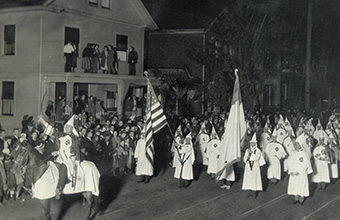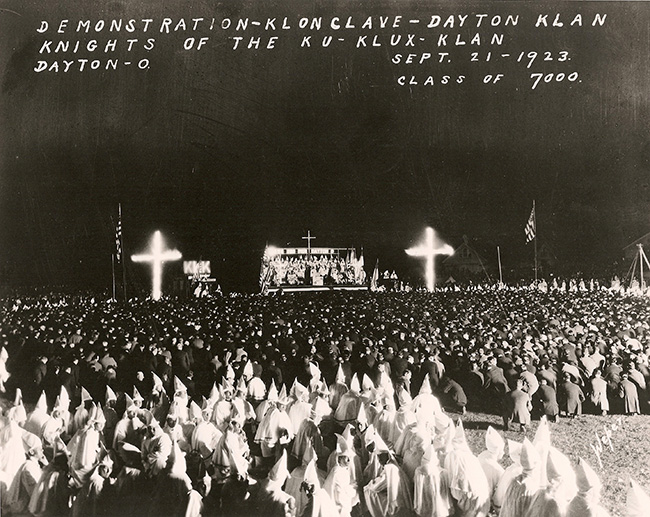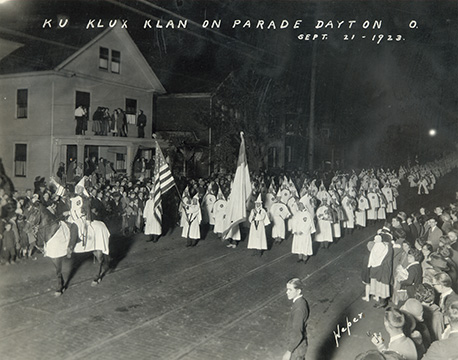College of Arts and Sciences Newsroom

The KKK and UD in the 1920s
Given the recent events in Charlottesville, it makes sense to think of the time - less than a century ago - when the Ku Klux Klan (KKK) terrorized the University of Dayton, and when students fought back.
In the 1920s, the KKK was very powerful in the United States - not just in the South. Of course, the Klan - especially in the South - terrorized African-Americans with cross burnings and acts of violence, including lynchings. But in the Midwest, the Klan focused much of its attention on Catholics. Why Catholics? Because the Klan - a hate group devoted to white Protestant supremacy - understood Catholics as not truly American.
Not only were there more Klansmen in Ohio than in any other state in the nation, but the city of Dayton was a Klan hotbed, with perhaps 10 percent of the 150,000 residents as card-carrying members. Some estimates place membership as high as 25 percent.
And the enemy was right next door. For one thing, in the 1920s, Catholics made up one-third of Dayton's population. Most of these Catholics were foreign-born or had foreign-born parents from eastern and southern Europe. More than this, the city's preeminent institution of higher education - the University of Dayton - was a Catholic university (which had been named St. Mary's College until 1920).
The University's presence enraged the Dayton Klan, which viewed the school as its top enemy. Local Klan newspapers repeatedly attacked the school, even claiming the University's ROTC program was a cover for training a Catholic army to fight religious wars against Protestants in the U.S. They held huge rallies - one attracted 32,000 enthusiastic supporters - just two blocks from campus at the Montgomery County Fairgrounds, where speakers attacked Catholics in general and the University in particular. There, they marched around in their white robes and hoods, set off fireworks, and erected 100-foot wooden crosses and lit them.
Under the cover of night, Klansmen again and again slipped onto University property and put up burning crosses designed to frighten students and faculty. Most dramatically, on the first night of Christmas break in December 1923, 40 carloads of Klansmen raided campus, not only to light an eight-foot cross on the west edge of campus, but also to set off 12 bombs. While there were only a few dozen students left on campus, they came running out of their residence hall. Outside in the cold they faced their attackers. Outnumbered, they were soon joined by hundreds of neighborhood residents - many of whom were Catholic - who were tired of the Klan provocations, and who joined the students in chasing the Klan cars off campus.
Students repeatedly chased the Klan off campus - yelling at them to have the guts to take off their hoods - and tore down their burning crosses. The Klan members got so tired of being chased away that they started lighting their crosses in Woodland Cemetery across the street, where there was a fence to protect them. But that didn't stop the students. When UD football coach Harry Baujan heard crosses were being lit in the cemetery, he rounded up his team and sent them to the cemetery to catch the perpetrators and rip off their sheets. The hooded Klan members spotted the football players and ran away into the darkness.
In the 1920s, University of Dayton students refused to be intimidated by the Ku Klux Klan. They stood up to the KKK's bigotry and hatred and violence. What they did in the 1920s seems like a good model for us today.
For more on this topic, please see my full 2013 article, Hearing the Silence: The University of Dayton, the Ku Klux Klan, and Catholic Universities and Colleges in the 1920s.
- Bill Trollinger, professor of history and Core integrated studies program director
Images courtesy of the Dayton Metro Library.


